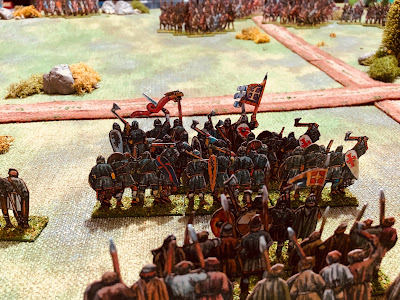Most of my miniatures are based on 4x3 inch bases in groups of 9 to 12 figures all fixed to the base. This works fine for me as I don't really like moving around units with too many bases, especially individually based figures. The exceptions to this are my three paper soldier armies (1066 Norman/Saxon, Jacobite Revolution, and War of the Spanish Succession) where each unit is made up of 6 to 9 bases. The reason for this number of bases is so I can lay them down in their storage boxes when not in use. Some of the figures are just too tall for easy storage.
 |
| Saxon paper soldier units with 6 bases per unit |
Up until now I have moved the multiple stand units while doing my best not to misjudge depth and catch some of the spears, causing them to get bent over. Anyway, this weekend I thought I would try and address the situation and make some movement trays using some MDF sheet.
 |
| About 20 movement trays were cut out sized 8x3 inches. |
 |
| The trays were painted green, then once dry painted with PVA glue and the scatter/flock lightly sprinkled over. I was not going for a full coverage, just enough to help break up the painted flat green look. |
 |
| A completed movement tray. |
My test of an unpainted movement tray showed there was little movement of paper soldiers when lifting and moving them around the tabletop. This is due to their very light weight. Adding the scatter/flock adds some more friction to the tray's surface and the figures only start to shift about a bit if held at an angle of more than 30 degrees.
 |
A 6 base Saxon Housecarl unit on a movement tray.
|
 |
| A 9 base WSS unit on a tray in line. |
 |
| A 9 base WSS unit in column, |
 |
| WSS artillery limbered. |
 |
| WSS artillery unlimbered. |
One advantage of the 6 base units is there is room on the movement tray for counters or dice to mark hits or other unit statuses.
 |
| Unit with hit counter (2 hits taken so far) |
 |
| Unit with dice as hit markers. Although the dice are more likely to slip off the tray than the figures. |
 |
| All set up for a One Hour Wargames game using the movement trays. Hopefully with no more spears getting bent over. |












Love the way you do your flats mate. The basing is a great idea and I’m sure will prevent some of the faff when moving large units around. Eat your heart out Wofun!
ReplyDeleteThe paper flats are great. They have allowed me to game in three periods I would not have normally started at minimal cost. Excluding the purchase of the books, it costs $2 per unit.
DeleteDo you cut those figures by hand? That is an excellent job.
ReplyDeleteYes, all cut be hand. When I print/photocopy the figures I increase the size by 50 percent so when cut out they are close to 40mm tall rather than 25mm. This makes them easier to cutout and I can better see the great drawing on them (my sight reducing as I am getting old).
DeletePendraken / Minibits in the U.K. sell little wooden squares designed to hold dice on bases. Very handy as the come in different shapes (line or 'L'), sizes and number (1, 2 or 3 dice).
ReplyDeleteThanks for the tip - I will have a look.
DeleteExcellent Idea!
ReplyDeleteThank you, they certainly speed up the game.
DeleteThey look great Peter. Basing adds so much to these, as it does with all figures.
ReplyDeleteRegards, James
Thanks. It certainly makes it much clearer what is a flank or frontal attack.
DeleteA little bit of magnetic sheeting under the bases and ferro-sheet movement trays and you could hold them upside down if you wished - you could even fight a battle up the the fridge!
ReplyDeleteFunny you should mention that. When I was testing to see how far I could turn the tray before they toppled, I did think if magnetic sheet, but the trays work well enough and cost next to nothing to make.
Delete